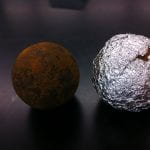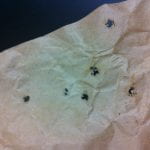DESCRIPTION:
As two rusty cannon balls (one covered in aluminum foil) are smashed together, sparks and a cracking sound are produced. The reaction that occurs is:
Fe2O3 (s) + 2Al (s) → Al2O3 (s) + 2Fe (s)
This exothermic reaction has a high activation energy that is overcome by the mechanical energy used to smash the cannon balls together. The large enthalpy change, -849 kJ/mol, offsets the overall unfavorable entropy change, -36.48 J/molK, giving a free energy change of -838 kJ/mol at 298K. When done on a larger scale, this reaction produces molten iron that is used in industry to weld railroad tracks together.
TOPICS COVERED:
– single replacement reactions
– redox
– exothermic reactions
– light
– sound
– chemical change
– energy transformations
– mechanochemical reactions
– activation energy
– thermodynamics
MATERIALS NEEDED:
– 2 rusty cannon balls
– aluminum foil
PROCEDURE:
1. Wrap 1 of the cannon balls in a layer of aluminum foil
2. Being careful that fingers are out of striking range, smash the balls together. A glancing blow works best. Practice to get the technique down before attempting in front of an audience.
ADDITIONAL COMMENTS:
To show evidence of heat produced in this reaction, the cannon balls can be smashed together with a piece of paper in between. Burnt holes will appear on the paper.
These balls can be purchased from Flinn: http://www.flinnsci.com/store/Scripts/prodView.asp?idproduct=16124
The Thermit Welding Company has information on the modern version of the railroad track welding process: http://www.thermit-welding.com/thermit_welding_process.php
SAFETY:
Safety goggles should be worn at all times. Gloves will protect hands from iron oxide. Sparks may fly up to several feet, caution should be taken with flammable objects in the surrounding area.
REFERENCES:
“Smashing Thermit Reaction.” Chem Fax! Flinn Scientific, Inc. 2009.
Shakhashiri, B.Z. Chemical Demonstrations; University of Wisconsin Press: Madison, 1983; Vol. 1, pp 85.

